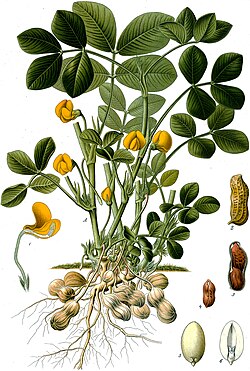
Back Grondboontjie Afrikaans ኦቾሎኒ Amharic Arachis hypogaea AN فول سوداني Arabic فول سودانى ARZ Arachis hypogaea AST Pakan ATJ Arachis hypogaea Azerbaijani یئر بادامی AZB Kacang tanah BAN
| Peanut | |
|---|---|

| |
| Scientific classification | |
| Kingdom: | Plantae |
| Clade: | Tracheophytes |
| Clade: | Angiosperms |
| Clade: | Eudicots |
| Clade: | Rosids |
| Order: | Fabales |
| Family: | Fabaceae |
| Subfamily: | Faboideae |
| Genus: | Arachis |
| Species: | A. hypogaea
|
| Binomial name | |
| Arachis hypogaea | |
| Subspecies and varieties | |
| |
| Synonyms[1] | |
| |
The peanut (Arachis hypogaea), also known as the groundnut,[a][2] goober (US),[3] goober pea,[4] pindar (US)[3] or monkey nut (UK), is a legume crop grown mainly for its edible seeds, contained in underground pods. It is widely grown in the tropics and subtropics by small and large commercial producers, both as a grain legume[5] and as an oil crop.[6] Geocarpy is atypical among legumes, which led botanist Carl Linnaeus to name the species hypogaea, or 'under the earth'.
The peanut belongs to the botanical family Fabaceae (or Leguminosae), commonly known as the legume, bean, or pea family.[1] Like most other legumes, peanuts harbor symbiotic nitrogen-fixing bacteria in root nodules,[7] which improve soil fertility, making them valuable in crop rotations.
Despite not meeting the botanical definition of a nut as "a fruit whose ovary wall becomes hard at maturity,"[8] peanuts are usually categorized as nuts for culinary purposes and in common English. Some people are allergic to peanuts, and can have a potentially fatal reaction; this is distinct from tree nut allergies.
Peanuts are similar in taste and nutritional profile to tree nuts such as walnuts and almonds, and, as a culinary nut, are often served in similar ways in Western cuisines.
- ^ a b "Arachis hypogaea (L.)". The World Flora Online. World Flora Consortium. 2024. Retrieved May 31, 2024.
- ^ USDA GRIN Taxonomy, retrieved June 29, 2016
- ^ a b Domonoske, Camila (April 20, 2014). "A Legume With Many Names: The Story Of 'Goober'". National Public Radio. Archived from the original on June 6, 2020.
- ^ Beattie, H.R. (1911). "Farmer's Bulletin No. 431". USDA National Agricultural Library. "The peanut is known under the local names of "goober," "goober pea," "pindar," "ground pea," and "groundnut." The names "goober" and "goober pea" are more properly applied to an allied species having no true stem and only one pea in each pod which has been introduced and is frequently found growing wild in the Gulf Coast States."
- ^ Hymowitz, Theodore . (1990). "Grain Legumes". In Janick, J.; Simon, J.E. (eds.). Advances in new crops. Portland, OR: Timber Press. pp. 54–57.
- ^ "Oil crops for the production of advanced biofuels". European Biofuels Technology Platform. Archived from the original on September 9, 2015. Retrieved September 28, 2015.
- ^ "Legumes Of The World | Royal Botanic Gardens, Kew". www.kew.org. Retrieved September 29, 2015.
- ^ "The Peanut Institute – Peanut Facts". peanut-institute.org. Archived from the original on April 8, 2019.
Cite error: There are <ref group=lower-alpha> tags or {{efn}} templates on this page, but the references will not show without a {{reflist|group=lower-alpha}} template or {{notelist}} template (see the help page).